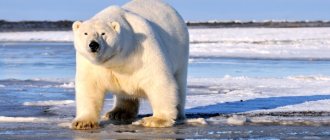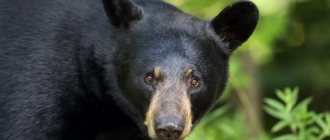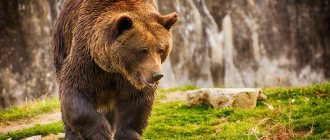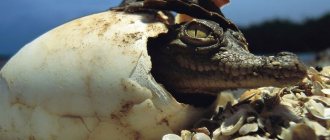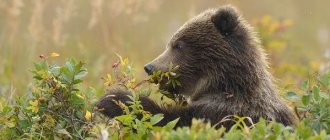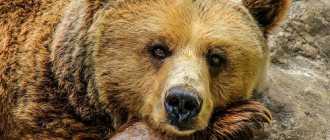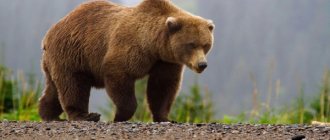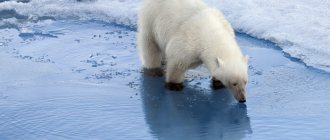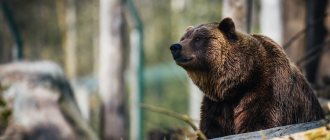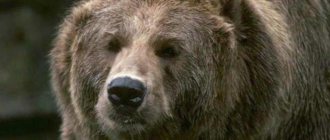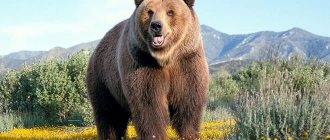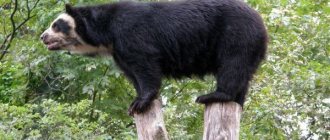Brown bear: description
The body of a brown bear is characterized as well-developed and strong, which is typical of all representatives of this family.
Appearance
The external appearance of a brown bear is characterized by such features as high withers, a massive head, and small ears and eyes. The tail is not particularly long and ranges from 6.5 to 21 centimeters. The paws are also massive and strong, armed with powerful, non-retractable claws. The feet are five-toed and relatively wide.
Animal sizes
Brown bears living in the European part of our territory grow up to one and a half to two meters in height, with an average weight of about 200 kg. Mammals living in the middle zone are 2 times smaller in size than individuals living in the European part. Far Eastern bears, as well as grizzly bears, are among the largest representatives of this family and grow up to 3 meters in size.
Color Variations
Brown bears are characterized by a rather variable color, which depends on a number of natural factors. Although brown is considered the classic shade, fur color can range from light fawn to bluish-black.
Interesting fact! It is not difficult to distinguish a grizzly bear from its other relatives, since hairs with white ends grow on its back, which is somewhat reminiscent of gray hair. These are the representatives of the family that live in the Himalayas, but the representatives inhabiting Syria are distinguished by a reddish-brown tint.
Lifespan
In the natural environment, brown bears live no more than thirty years, although some individuals do not live up to half of this term. In artificial conditions, brown bears live much longer, living up to 50 years, or even older.
Brown bears. Documentary.
Types of brown bear with photos
The brown bear species consists of several subspecies, which are characterized by geographical distribution patterns, which form unique geographical races. Moreover, the subspecies differ in both color and size.
You should pay attention to the following subspecies:
- European brown bear . The following maximum indicators are considered characteristic of this subspecies: body length about 2 and a half meters, tail length about 15 cm, height at the withers about 110 cm, body weight up to 300 kg. It is considered a rather massive subspecies, with a strong body and a pronounced hump at the withers. Depending on the habitat, the coat color can range from light grayish-yellow to dark blackish-brown. The body is covered with fairly long and thick fur.
- The Caucasian brown bear is slightly smaller in size, since the maximum body length is slightly more than 2 meters, with a weight of no more than 240 kg. It differs from the European subspecies in having a less bright coat color, while its coat is short and coarse. The coat color varies from pale straw to a uniform gray-brown. A characteristic large dark spot can be seen in the withers area.
- East Siberian brown bear . It is distinguished by a large skull and weighs almost 350 kilograms. The body is covered with soft long fur, which has a characteristic shine. The coat can be colored in tones from light brown to dark brown. At the same time, there are individuals whose color includes clearly visible inclusions of yellowish or black tones.
- Ussuri or Amur brown bear. In the vastness of our country, this subspecies is also called the black grizzly. Adult males are very impressive in size, reaching a weight of almost half a ton. This subspecies is characterized by the presence of a large, physically developed skull with an elongated nasal region. The fur is almost black. The subspecies is distinguished by the presence of long hair on the ears.
One of the largest subspecies is the Far Eastern or Kamchatka brown bear, whose body weight exceeds 500 kilograms. Adult individuals are characterized by a large, massive skull, the front part of which is relatively wide and, as it were, raised upward. The body is covered with long, dense and soft fur, which is pale yellow, blackish-brown or completely black in color.
Links[edit]
- ^ a b John Snyder; Bernard Stonehouse, ed. (2007). Prospects for polar tourism
. CABI. ISBN 1-84593-247-1. - ^ abcd V. G. Geptner; Naumov N.P., editor. (1998). Mammals of the Soviet Union. Moscow: Higher School [ Mammals of the Soviet Union, Volume II, Part 1a, Sirenia and Carnivora (Sea Cows; Wolves and Bears)
]. II, part 1a. Washington, DC, USA: ISBN Science Publishers, Inc. 1-886106-81-9. - ^ a b McLellan B.N.; Rayner, D. (1994), Review of Bear Evolution (pdf), 9
, International Conference Bear Res. and Management, pp. 85–96, retrieved September 26, 2011. - ↑
Robert Rausch, On the status of some Arctic mammals (pdf), retrieved September 26, 2011. - ↑
Revenko, I.A.
(1994), Reaction of the brown bear (Ursus arctos piscator) to humans in Kamchatka (pdf), 9
, Petropavlovsk-Kamchatsky, 683024, Russia: Kamchatka Institute of Ecology and Environment, Rybakov Ave., 19a, p. 107–108, accessed September 26, 2011. CS1 main: location (link) - "Kamchatka brown bear". Kamchatkapeninsula.com
. Retrieved September 26, 2011. - Harding, Luke (2008-07-23). "Bears eat two workers in remote Russian region". The keeper
. ISSN 0261-3077. Retrieved June 10, 2022.
Habitat of the brown bear
If we talk about the natural habitats of brown bears in our time, there is no clear answer to this question, since there are significant changes due to the human factor.
Until recently, the habitat of these predators extended from the borders of Great Britain to the Japanese Islands, including from Alaska to the central regions of Mexico.
Nowadays, when brown bears are actively exterminated and evicted from the regions they inhabit, the largest populations are observed in the western regions of Canada, as well as in Alaska. In our country, brown bears are found in vast forest areas that are still untouched.
How many years do they live
The animal is one of the largest predators on the planet and has virtually no natural enemies. The exception is a tiger or wolves that attack in a pack. In rare cases, a bear can be fatally injured while hunting deer, elk or bison. The most vulnerable are cubs and adults weakened due to lack of food or illness.
The premature death of bears is also caused by territorial or mating fights between males. Sometimes large males kill young females who do not want to mate.
Taking into account all these factors, the average life expectancy of a brown bear in nature is 25-30 years. When kept in captivity, animals live up to 45-50 years.
Lifestyle of a brown bear
The predator displays its main activity in the morning and evening twilight. In this case, the animal orients itself in space due to its fine hearing and sense of smell. If we talk about the animal’s vision, it is weak. Despite their impressive size and weight, bears move easily and almost silently, thanks to fast and fairly confident movements.
Interesting to know! Bears are capable of running at speeds of up to 60 km/h. They are also excellent swimmers, but have difficulty moving in deep snow.
Brown bears lead a sedentary lifestyle, but young individuals migrate long distances in search of sexual partners. Each individual knows the boundaries of its territory, as it marks and protects it from encroachment by outsiders. When it is comfortable and warm outside, animals choose resting places for themselves, sitting on the ground among tall grass or in dense thickets of bushes. When cold weather begins to set in, adults are busy looking for places to winter.
Preparation for sleep
Clubfoots begin to prepare for their wintering in mid-summer. It's a brown bear! The description of his preparation for bed is probably known to many people, because there is nothing secret or surprising about it. Six months before the onset of cold weather, they need to find a suitable place for their winter shelter, equip it and, of course, increase their reserves of subcutaneous fat. Most often, bear dens are located under logs and inversions, under the roots of huge and massive trees - cedars or spruces.
Sometimes these predators dig themselves “dugouts” directly in the coastal cliffs of rivers. If during this time the bear has not found a secluded place for its winter shelter, it digs a large hole, after which it strengthens its walls with vertically protruding branches. Brown bears use them to block the entrance hole, simultaneously camouflaging themselves and isolating themselves from the outside world for several months. Immediately before going to bed, an animal that has gained a sufficient amount of subcutaneous fat carefully confuses its traces of being near the den.
It is worth noting that the most solid and practical bear dwellings are considered to be unpaved dens. If the predator is lucky, it will lie in the ground for the whole winter. Such dens are located deep underground and keep the clubfoot warm. Near the entrance to the soil den you can find various trees and shrubs covered with yellowish frost. Experienced hunters know that the hot breath of a clubfoot gives the frost its color.
Diet of brown bears
It is believed that brown bears, although they are predators, are omnivores. At the same time, the basis of the diet is food items of plant origin. Therefore, they feed on everything they can find on their territory: berries, nuts, acorns, roots, tubers, as well as stems of various plants. In addition, bears eat insects in the form of ants, worms, lizards, frogs, field and forest rodents.
Adults are capable of attacking juvenile artiodactyls, such as roe deer, fallow deer, deer, wild boar, moose, etc. Bears have well-developed limbs, so with one blow they can break the spine of their potential prey. After this, the predator hides the carcass in branches and leaves, after which it guards it until it is completely eaten. Bears often go to the banks of rivers, seas and oceans, where they hunt fish, seals, seals, etc.
Larger individuals are able to take prey from weaker members of their family.
It is important to know! Brown bears, regardless of age, have excellent memory, so they remember berry or mushroom areas. At the same time, they unmistakably find their way to these places.
The Far Eastern brown bear feeds on salmon going to spawn. During this period, bears actively feed, stocking up on nutrients. When the year turns out to be a lean year and a poor food supply, bears attack domestic animals or domestic animals.
Reproduction and offspring
Somewhere in May, brown bears begin their mating season, which can last up to two months. During this period, males enter into fights for the right to fertilize a female. In this case, females can mate with several males, regardless of the outcome of the fights. Pregnancy is characterized by the fact that the development of the embryo occurs only during the period of hibernation of bears. Cubs appear after 6-8 months. They are born absolutely helpless, deaf and covered with sparse hairs. The female gives birth to 2 to 3 babies, whose length is about 25 cm and weighs about 500 grams.
Interesting fact! While in the den, the cubs feed on milk. This lasts for 3 months, after which the juveniles begin to develop milk teeth. Starting from this period, the cubs independently find food for themselves, in the form of insects, berries and vegetation. Despite this, they continue to feed on the female’s milk for another 1.5 years, or even more.
After the birth of the next offspring, which is possible once every 3 years, the babies are also cared for by the nurse daughter who appeared in the previous litter. Young bears stay near the female for 3 years until they reach puberty.
Brown bear hibernation
Brown bears, although they hibernate during the winter, are not so active if we compare this process that occurs with other mammals. The hibernation period of a brown bear is characterized by the fact that its body temperature, breathing intensity and heart rate are almost at the same level as before hibernation. In the first days he practically does not sleep, but only dozes.
Despite this half-hibernating state, the bear listens sensitively to all sounds. In case of danger, he is ready to immediately leave the den. When the winter is warm and there is little snow, some individuals do not sleep in winter, since they can easily find food. When severe cold occurs, predators hibernate, and this period can last no more than a month. During this period, the animal feeds on subcutaneous fat, which the bear managed to accumulate before the onset of cold weather, although this is not always possible.
Preparatory period before bed
For winter sleep, bears choose deaf, dry places, within windbreaks or under the roots of fallen trees. Adults, with the help of powerful paws, dig deep and voluminous holes for themselves. In addition, they can occupy caves and crevices in rocks. Pregnant females try to dig a shelter with the future offspring in mind. After this, the den is covered from the inside with moss, spruce branches and fallen leaves.
Important point! Once born, cubs always spend the winter in a den with the female. Bear cubs that have entered their second year of life can also spend the winter in this company.
All solitary individuals spend the winter alone, although on the territory of Sakhalin and the Kuril Islands there are bears that spend the winter in the company of several of their relatives.
Duration of hibernation
Brown bears, depending on weather conditions and a number of other factors, can stay in a den for up to six months. As a rule, the bear lies down in a den after feeding on the required amount of nutrients. This process is also influenced by other factors, including the physiological state of the animals.
It is important to know! An old animal that has managed to stock up on all the necessary nutrients goes into hibernation much earlier, even before the first snow falls. Young individuals that have not had time to fatten can lie down in a den at the end of autumn or at the beginning of winter.
In this regard, the hibernation process can drag on for several weeks or months. First of all, pregnant females go to the den, and last of all, old, weakened males. A brown bear can winter in the same den for several seasons if it is not occupied by a stronger individual.
Bears-rods
Bears that for some reason were unable to stock up on fat for the winter do not hibernate and are therefore called “connecting rods.” This is due to the fact that the animal wanders around the surrounding area all winter in search of food. It is easy to distinguish him from other bears by his uncertain, shaky gait and tattered, exhausted appearance.
Interesting fact! Having met a dangerous opponent, a brown bear stands on its hind legs and lets out a loud roar. In a duel, he uses his front paws to knock down his opponent.
Often, in search of food, bears appear in places where people live. Connecting bears are quite common in northern regions where harsh winters prevail. This phenomenon can be widespread, especially in lean years, with a frequency of once every 10 years. It is often necessary to shoot such animals because they pose a certain threat to humans. Since they are hungry, they can attack humans.
Bear protection equipment
Separately, I would like to talk about weapons (we mean firearms) and active means of protection against bears, as this topic also raises many questions and disputes.
An experienced guide usually carries with him a small arsenal of various devices (false flares, hunter signals, sprays, etc.) that create loud noise, bright flashes or an unpleasant smell for the bear. Such protective equipment can serve as an excellent help in avoiding a meeting with a bear if you suspect that it is wandering somewhere nearby. And, if the meeting took place, they can help drive him away. For a bear, all these noises and flashes are an extremely unusual phenomenon, which causes animal fear and turns on the instinct of self-preservation.
For a bear, all these noises and flashes are an extremely unusual phenomenon, which causes animal fear and turns on the instinct of self-preservation.
Rockets and Hunter Signals
I would also like to say something about the rockets and hunter signals! Some advise launching them directly at the bear, arguing that “it will set the fur on fire and the bear will get scared,” but such shooting to kill can, on the contrary, provoke the bear into rash actions. It is better to shoot in the direction of the animal; when it sees that something “fiery” is flying in its direction, it will hasten to leave.
Sprays
There are also special cans with liquid, which, when you press a button, they release at a distance of up to 5-7 meters, creating a caustic cloud. This remedy is quite effective if this cloud envelops the bear's face, thereby irritating the eyes and nose. Considering the sensitive sense of smell of bears, this is very unpleasant for them! But such means, as you noticed, are effective over a short distance and in the hands of a trained person, in our case a guide. Therefore, and in general, you should not bring it to close contact!
A few words about firearms
The most important thing is that the presence of weapons creates imaginary security! The fact is that it is not a fact that you will be able to use it correctly and skillfully. Many, knowing that someone in the group has a gun, begin to neglect other rules of safe behavior in the wild, completely relying on weapons, thereby increasing the chance of meeting a bear. You need to know that it is not so easy to kill a bear in the event of an unexpected meeting. Even if you noticed it earlier, this does not mean that you will be able to take a shot to kill. Experienced experts recommend using a gun as a “noise generator” and a way to show that you can reach a bear from afar by shooting in the air or close to it, dousing the bear with spray or earth.
Population and species status
Brown bears are not of great commercial importance, but are the object of sport hunting and poaching. This is due to the fact that bear skins are used as floor coverings, and the meat is considered a delicacy, so it is bought by restaurants to prepare expensive dishes.
The fat of bears, as well as bile, has medicinal properties. Today, according to experts, there are no more than 200 thousand individuals on the entire earth. This fact was the reason that bears were included in the Red Book and assigned the status of “endangered”.
Be careful, connecting rod!
Scientists say that bears do not sleep soundly. During short-term thaws, these predators can awaken and even leave their winter shelters for a while. At this time, the clubfooted ones walk through the winter forest, stretching their bones. As soon as it gets colder again, the furry heavyweights return to their shelter, covering up the traces of their stay outside the den. However, such habits of a brown bear are just flowers!
It also happens that some bears, due to malnutrition in the autumn-winter period, cannot gain the required weight, find and arrange their home. In this case, they do not lie in the den at all. Not having time to accumulate the reserves of subcutaneous fat necessary for a comfortable winter, the animal simply wanders through the snowy forest, as if restless. People called such poor fellows “connecting rods.” The connecting rod bear is a very dangerous and extremely aggressive animal! At this time, it is better not to mess with him at all, since the beast is very hungry, incredibly angry and attacks almost everything that moves.
